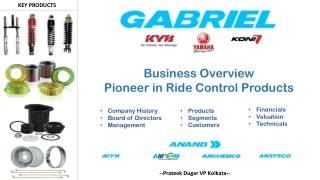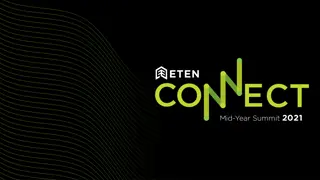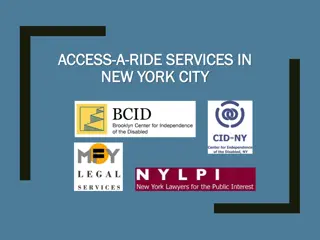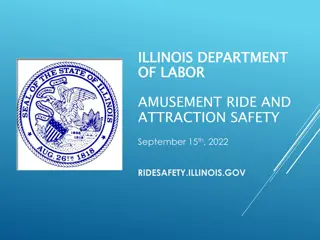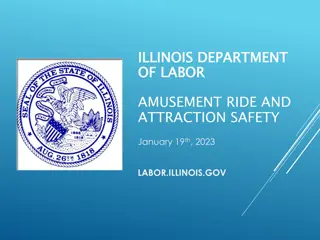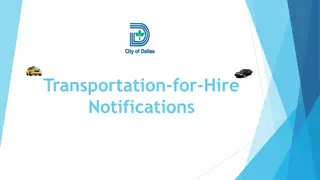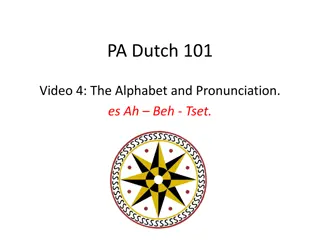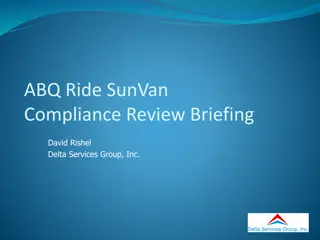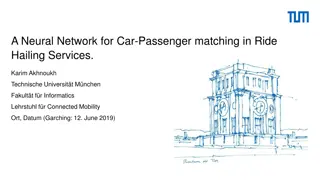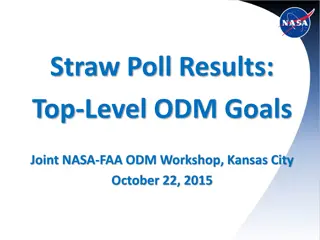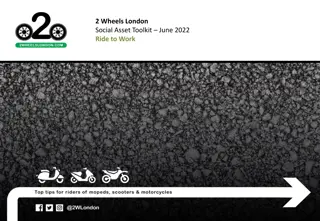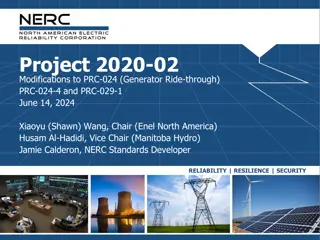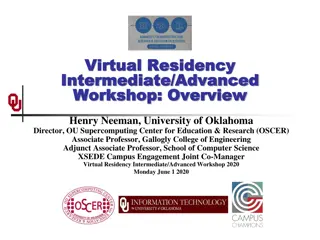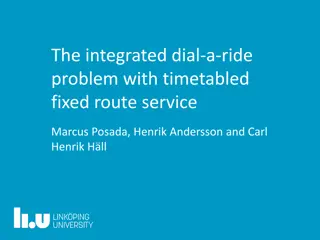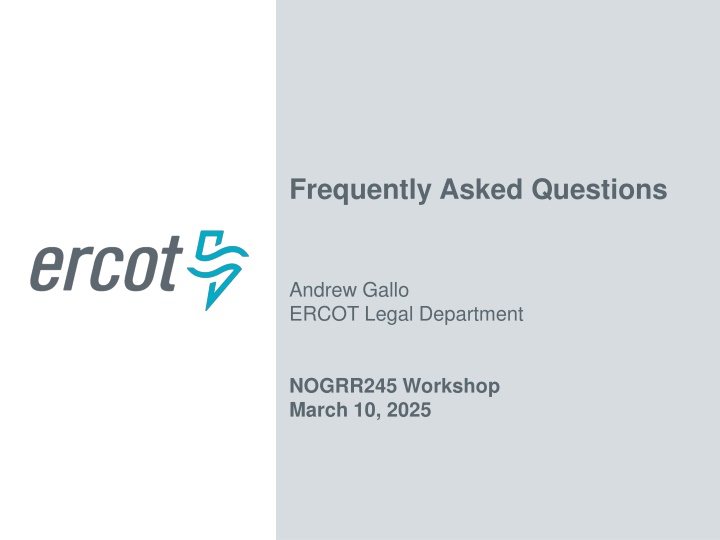
WGR Types and Compliance Requirements
Learn about the different types of Wind Generation Resources (WGR) and the compliance requirements for Type 1, Type 2, and Type 3 WGRs according to NOGRR245. Find out the key distinctions and regulations to ensure proper protection settings and maximize performance in accordance with IEEE standards.
Download Presentation

Please find below an Image/Link to download the presentation.
The content on the website is provided AS IS for your information and personal use only. It may not be sold, licensed, or shared on other websites without obtaining consent from the author. If you encounter any issues during the download, it is possible that the publisher has removed the file from their server.
You are allowed to download the files provided on this website for personal or commercial use, subject to the condition that they are used lawfully. All files are the property of their respective owners.
The content on the website is provided AS IS for your information and personal use only. It may not be sold, licensed, or shared on other websites without obtaining consent from the author.
E N D
Presentation Transcript
Frequently Asked Questions Andrew Gallo ERCOT Legal Department NOGRR245 Workshop March 10, 2025
NOGRR245 FAQs Disclaimer: ERCOT attempted in good faith to accurately respond to questions but to the extent an answer conflicts with the actual wording in the Nodal Operating Guides, the latter prevails. NOGRR245@ercot.com set up several months ago As of the date these slides were created, ERCOT has received 49 emails Responded to all of them Typically, team confers to respond to emails Doing the best we can ============================================================ Question: What is the difference between Type 1, 2, and 3 WGR? Answer: Type 1 WGR uses directly-connected induction generators (not IBR) Type 2 WGR uses induction generators with external resistance control (not IBR) Type 3 WGR uses doubly fed induction generators (is IBR) 2 PUBLIC
NOGRR245 FAQs Question: Should IBRs/Type 1/Type 2 WGRs w/ Standard Generation Interconnection Agreements (SGIAs) dated before 8/1/24 maximize protection settings 1st and then determine if exemptions are needed; i.e., maximize settings even if they currently comply with NOG 2.9.1.2? Answer: All IBRs/Type 1/Type 2 WGRs must maximize protection settings first and then determine exemptions needed ERCOT first proposed NOGRR245 to require IEEE 2800-2022 requirements for all IBRs/Type 1/Type 2 WGRs (regardless of SGIA date) due to ride-through failures on ERCOT System and based on NERC and IBRWG recommendations Stakeholders did not like that proposal because of impact on existing facilities but acknowledged Resources could perform better either by tweaking settings and parameterization or performing software/firmware upgrades Maximization language was compromise so existing Resources could improve ride-through capability while not having to make expensive hardware upgrades Nodal Operating Guides (NOG) contain minimum compliance requirements, but Resources shall increase ride-through capability to maximum amount equipment will allow (w/n equipment limits and consistent with Good Utility Practice) If ERCOT discovers Resource did not increase ride-through capability to maximum amount equipment will allow, it could refer Resource to PUCT for not following NOG requirements 3 PUBLIC
NOGRR245 FAQs Question: Once the Legacy requirements (NOG 2.9.1.2) are met, will Resource meet compliance? Answer: NOG states Resources shall maximize protection systems, controls, and other plant equipment (w/n equipment limitations and consistent with Good Utility Practice) to achieve, as close as reasonably possible, capability and performance in IEEE 2800-2022, sections 5, 7 and 9 (and not just meet minimum requirements in Section 2.9.1.2), Resource could be considered out of compliance However, if Resource in good faith did all it could to maximize performance of protection systems, controls, and other plant equipment to achieve, as close as reasonably possible, capability and performance in IEEE 2800-2022, sections 5, 7 and 9 and Resource still could meet only the capability and performance in NOG Sec. 2.9.1.2, Resource would not be considered out of compliance 4 PUBLIC
NOGRR245 FAQs Question: We have a Resource with an SGIA dated after 8/1/24 (or an existing Resource going through PG Sec. 5.2.1(1)(c) Generator Interconnection or Modification (GIM) process); does the Resource have to meet the IEEE 2800-2022 performance criteria or the requirements in NOG Sec. 2.9.1.1? Answer: Basically, the Resource must meet both sets of requirements Specifically, IEEE 2800-2022 contains ride-through curves and other general requirements not necessarily performance-based Sec. 2.9.1.1 requirements are somewhat different than IEEE 2800-2022 and contain specific ride-through requirements for ERCOT Region NOG require Resource to maximize ride-through capability to meet and, if possible, exceed capability/performance in IEEE 2800-2022 as well as FRT (NOG 2.6.2.1) and VRT (2.9.1.1 Preferred ; 2.9.1.2 Legacy ) All Resources should strive to meet or exceed IEEE 2800-2022, while Required Criteria appear in NOG 2.6.2.1 (FRT) and 2.9.1.1/2.9.1.2 (VRT) For Resources with an approved exemption or extension, documented maximum ride- through capability becomes its compliance requirement 5 PUBLIC
NOGRR245 FAQs Question: Based on Dynamics Working Group (DWG) Procedure Manual Sec. 3.1.5.4, Resources not subject to Preferred Voltage Ride Through requirements of NOG 2.9.1.1 must only ride-through the first dip in the Legacy Low Voltage Ride-Through requirements of NOG 2.9.1.2; must we run voltage dip of 0.7 pu at Point of Interconnection (POI) for Resource with SGIA before 8/1/24? Answer: Yes. 6 PUBLIC
NOGRR245 FAQs Background: Project w/ SGIA after 8/1/24 went through 8/1/24 Quarterly Stability Assessment (QSA) with no GIM post-QSA, no equipment change, no project size or data assumption changes from QSA study. Question: Does NOGRR245 in its entirety apply to project? Answer: Because Resource has SGIA after 8/1/24, FRT capability and performance must be set to maximum level equipment allows to meet/exceed NOG Sec. 2.6.2.1(1) - (5) ASAP but no later than 12/31/25 (or synchronization if synchronizing after 12/31/25) Resource must maximize VRT capability to meet or exceed IEEE 2800-2022 Sections 5, 7 and 9, including any intra-standard cross-references or definitions (consistent with Good Utility Practice) and NOG 2.9.1.1(1) - (7) contains Required Criteria 7 PUBLIC
NOGRR245 FAQs Question: Our understanding of the process is: 1. Verify maximum capability from OEM for VRT and FRT capability and performance (or obtain from OEM documentation, if provided) 2. Use maximized settings in latest plant model, run simulations to validate capability and performance, and tune settings further, if needed a. If capability and performance issues are found, submit either extension or exemption request by 4/1/25, if needed b. If no issues found and maximized settings in model differ from field settings, initiate GIM process 3. Once GIM process completes, implement maximized settings in field consistent with model Is this correct? Answer: Generally, yes, but if model settings differ from field settings, Resource must follow PG Sec. 5.5(4) (new generator) or Sec. 5.5(6) (existing Resource) before modifying a control setting or equipment that impacts dynamic response at POIB Once Resource submits required data and info and ERCOT/TSP approve proposed modifications, Resource can implement modifications in the field 8 PUBLIC
NOGRR245 FAQs Question: If my Resource s original SGIA date was before 8/1/24 but the SGIA was amended after 8/1/24, which date applies for the ride-through performance and capability requirements? Answer: The original SGIA date Question: Does the NOG extension language mean we can get an extension from the 4/1/25 deadline to submit exemption requests? Answer: No. The NOG extension language means only you can request an extension to meet the ride-through capability and performance requirements beyond 12/31/25 9 PUBLIC
NOGRR245 FAQs Question: If OEMs state they will have software updates to improve equipment ride- through capability (i.e., maximize) but do not know or will not release the details before 4/1/25, REs cannot provide the information required by the NOG to request an extension or exemption; what should we do in that case? Answer: NOG approved by PUCT - require submittal of all required information on or before 4/1/25 - ERCOT has no authority to change or extend that deadline You should follow NOG requirements to ensure Resources ride-through capabilities are set to maximum level the equipment allows ASAP but no later than 12/31/25 You should provide to ERCOT the best info you have with as much detail as possible by 4/1/25 and supplement it with additional information as soon as you receive it ERCOT staff will take those actions into account when performing studies to determine whether to grant an extension or exemption Keep in mind, ERCOT staff cannot assess Resources impact on ERCOT System reliability until they know all Resources actual post-maximization capabilities 10 PUBLIC
NOGRR245 FAQs Question: Our inverter protection settings were established based on equipment capability rather than absolute limits, meaning configured to trip at or near those limits; existing settings meet existing requirements and do not risk tripping within ride-through requirements; do you agree it does not merit making updates to protection settings because the effort and cost to adhere to NOGRR245 by maximizing settings to absolute equipment limits is not justified? Answer: NOGRR245 was drafted to require Resources to maximize ride-through performance and capabilities, not just meet minimum requirements NOG require all IBRs, Type 1 WGRs and Type 2 WGRs to maximize to the fullest extent possible frequency and voltage ride-through performance and capability but that does not mean absolute limits of equipment capability - appropriate margins in accordance with OEM guidance and Good Utility Practice are expected to prevent equipment damage when maximizing performance If ERCOT learns a Resource did not maximize its protection systems, controls, and other plant equipment (w/n equipment limitations and consistent with Good Utility Practice) to achieve, as close as reasonably possible, the capability and performance in IEEE 2800-2022, sections 5, 7 and 9 (and not just meet minimum requirements), the Resource could be considered out of compliance 11 PUBLIC
NOGRR245 FAQs Question: If current settings are not set at minimum requirement but also not set to absolute maximum capability, setting changes are not required, is that correct? Answer: NOG do not require setting equipment to absolute maximum capability but do require you to ensure ride-through capability and performance is not merely set at minimum level in NOG if you can maximize ride-through capability beyond the minimum level consistent w/ OEM recommendations and Good Utility Practice NOG Sec. 2.9.1(8) provides maximizing means making, software, settings, firmware, and parameterization changes, which includes any memory upgrades to accommodate such changes that do not involve modifying other Resource equipment or components, to maximize capabilities of the Resource with respect to the specified IEEE 2800-2022 requirements in accordance with Good Utility Practice. (emphasis added) If you believe you maximized Resource ride-through capability to maximum extent the equipment allows (consistent with Good Utility Practice) and Resource at least meets capability and performance requirements in NOG Sections 2.6 and 2.9 (whichever apply to it), no additional setting changes are required 12 PUBLIC
NOGRR245 FAQs Question: What does modification was fully implemented prior to January 1, 2028 in NOG Sec. 2.9.1(1)(a)(ii) mean (i.e., what criteria apply to consider this milestone achieved)? Answer: NOG Sec. 2.9.1(1)(a)(ii) requires modification be fully implemented before 1/1/28 PG Sec. 5.2.1(1)(c)(iii) provides that modifying any IBR control settings or equipment that impacts dynamic response at Point of Interconnection (POI) in a manner deemed to require further study per PG Sec. 5.5(5) must follow requirements in PG Sec. 5.2 Based on plain meaning of fully implemented, modifications must have gone through the ERCOT processes in PG and be completed i.e., Resource is commissioned 13 PUBLIC
NOGRR245 FAQs Question: Do Type 3 wind projects that undergo repower have until 1/1/2028 to comply with NOGRR 245 modification requirements? Answer: Type 3 WGRs are "inverter-based" so all requirements applicable to IBRs apply to them NOG Sec. 2.9.1.1 applies to IBRs w/ SGIA dated after 8/1/24 and any existing Resources making modifications covered by Planning Guide (PG) Sec. 5.2.1(1)(c) after 8/1/24 If Resource w/ SGIA pre-dating 8/1/24 makes modifications covered by PG Sec. 5.2.1(1)(c) and fully implements the work by 1/1/28, the VRT requirements in NOG Sec. 2.9.1.2 are compliance obligation but Resource still must maximize VRT capability to the fullest extent equipment allows (consistent with Good Utility Practice) If work not done by 1/1/28, post-modification Resource must meet NOG Sec. 2.9.1.1 14 PUBLIC
NOGRR245 FAQs Question: If the intent was to reach Commercial Operations Date (COD) before 1/1/28 but COD is delayed beyond the owner s control, can you confirm only Legacy requirements must be met? Answer: The analysis does not focus on COD but on when the Resource fully implements the modifications by 1/1/28 NOG were approved by stakeholders, Board and PUC ERCOT cannot change dates in NOG If Resource does not fully implement modifications prior to 1/1/28, NOG Section 2.9.1(8) requires it to meet and, if possible, exceed IEEE 2800-2022 sections 5, 7 and 9 If it cannot meet IEEE 2800-2022 after maximizing capabilities, NOG Section 2.9.1(1)(a)(ii) requires it to meet Preferred requirements in Section 2.9.1.1 15 PUBLIC
NOGRR245 FAQs Question: If a Resource goes through repowering and reaches COD before 1/1/28, what requirements must it meet: legacy or preferred? Answer: Capability and performance requirement for all IBRs, Type 1 WGRs and Type 2 WGRs is to maximize performance of protection systems, controls, and other plant equipment (w/n equipment limitations and consistent with Good Utility Practice) to achieve, as close as reasonably possible, capability and performance in IEEE 2800-2022, sections 5, 7 and 9, not just meet minimum requirements in Section 2.9.1.2 (Legacy) If Resource cannot meet/exceed IEEE 2800-2022 requirements, NOG Sec. 2.9.1(8) requires it to maximize protection systems, controls, and other plant equipment (w/n equipment limitations and consistent with Good Utility Practice) to achieve, as close as reasonably possible, IEEE 2800-2022 After maximizing, NOG Sections 2.9.1(1)(b) and 2.9.1.2(8) require Resource to meet and, if possible, exceed the requirements in Sections 2.9.1.2(1)-(7) So long as Resource repowering is fully implemented prior to 1/1/28, NOG Sections 2.9.1(1)(a)(ii) and 2.9.1(4) provide it must meet capability and performance in Sec. 2.9.1.2. 16 PUBLIC
NOGRR245 FAQs Question: If a repower without changing the inverters occurs before 1/1/28, what requirements does the project need to meet: Legacy or Preferred? Answer: Analysis does not focus solely on whether inverters are changed Any modification of existing Resource meeting requirements in PG Section 5.2.1(1)(c) must go through GIM process Question: What if repower without changing inverters occurs after 1/1/28, what requirements does the project need to meet: Legacy or Preferred? Answer: Analysis focuses on when Resource fully implements modifications (in this case after 1/1/28) In this case, NOG 2.9.1(8) requires Resource to meet and, if possible, exceed IEEE 2800- 2022 sections 5, 7 and 9 If, after maximizing capabilities, it cannot meet IEEE 2800-2022, NOG 2.9.1(1)(a)(ii) requires it to meet capability and performance requirements in Section 2.9.1.1. 17 PUBLIC
NOGRR245 FAQs Question: VRT models for projects must be updated to meet NOGRR245 capability and performance requirements; when must model updates be completed and what changes must be made? Answer: Models must accurately reflect plant performance (NOGRR245 did not change that) Model updates submitted after 10/1/24 (e.g., for QSA qualification, etc.) must include model quality tests per DWG Procedure Manual Section 3.1.5 https://www.ercot.com/files/docs/2024/11/08/05.%20%20Dwg-Procedure- Manual-Revision-22-clean.docx 18 PUBLIC
NOGRR245 FAQs Question: Does it suffice to provide as-built Model Quality Test (MQT) models including preferred curves and maximized protection settings and submit for ERCOT review? Answer: Yes, as-built MQT is required per PG process for commissioning Must also submit NOGRR245 template prior to synchronization Question: Do we have to restudy stability for a Resource with a SGIA after 8/1/2024? Answer: If a previously submitted model already reflects maximized capabilities, restudy may not be necessary However, even if restudy is not necessary, interconnecting entity (IE) must submit updated MQT per current DWG Procedure Manual prior to qualifying for QSA 19 PUBLIC
NOGRR245 FAQs Question: Assuming the QSA model did not evaluate Preferred VRT Requirements (NOG Sec. 2.9.1.1), would a revised model suffice? Answer: The NOG performance capability and performance requirements apply regardless of what was reviewed for QSA In general, past QSA qualifications will not be revisited, but as-built model update required by NOG and PG must include MQT in accordance with DWG Procedure Manual As models must accurately reflect plant performance, any failure to meet required performance in MQT must be corrected 20 PUBLIC
NOGRR245 FAQs Question: In PSCAD, should we run the frequency protection test for 299 seconds (or other requirements specified with long time durations) because the simulation is long in real time. Answer: NOG 2.6.2.1(1) shows minimum ride-through time (in seconds) For frequency > 61.6 Hz and 61.8 Hz, Resource must ride-through for at least 299 seconds ERCOT does not currently require a specific simulation demonstrating performance for this case, but Resource must comply with the requirement 21 PUBLIC
NOGRR245 FAQs Question: What models are required by April 1, 2025 (e.g., PSCAD, PSSE, TSAT, etc.) assuming IFRTCR/IVRTCR is being submitted? Answer: You should submit all required models If PSCAD model was not previously required, PSCAD model would not technically be required solely due to submission of IFRTCR/IVRTCR However, given industry trends, PSCAD model may very well be required for all Resources at some point =============================================================== Question: Do any of the balance of plant relays (e.g., collector system over- voltage, under-voltage, POI voltage/frequency protections, etc.) need to be included in models? Answer: To the extent balance of plant equipment affects the Resource s ability to ride-through system disturbances, it should be included in the model 22 PUBLIC
NOGRR245 FAQs Question: Are simulation results showing compliance to the items below necessary? Negative sequence current injection and angle [IEEE 2800 Section 7.2.2.3.4 ] IBR performance specifications at the unit terminals [IEEE 2800 Section 7.2.2.3.5 Table 13] ROCOF [IEEE 2800 Section 7.3.2.3.5] Transient Overvoltage [IEEE 2800 Section 7.2.3] Consecutive voltage deviations ride-through [IEEE 2800 Section 7.2.2.4] Answer: The referenced requirements are not specifically evaluated in ERCOT MQTs Responses to questions in DocuSign template contain Resource capabilities and expected performance re: those items (rather than demonstration in specific simulations) However, models must accurately represent device dynamics and model verification reports supporting model data based on field settings must be provided per DWG Procedure Manual per PG Sections 6.2(5)(a) and (b) Those reports must demonstrate the commonly tuned model parameters match site- specific settings in the field You can explain modeling limitations in DocuSign form 23 PUBLIC
NOGRR245 FAQs Question: If simulations are required to verify compliance, does ERCOT provide guidance on the methodology/approach of simulations and evaluation or would it suffice to follow the guidelines in IEEE 2800-2022 itself, together with reasonable engineering judgement? Answer: All NOG requirements mandate operating performance regardless of model or test results Presumably, accurate models (PSSE, TSAT, PSSE) give Resource owners confidence facilities comply with requirements ERCOT MQTs are example checks performed to provide confidence facilities meet certain requirements However, ERCOT does not mandate specific tests for every requirement One goal of DocuSign and GIM processes is ensuring Resource owners know and understand ride-through requirements Complying with requirements is mandatory regardless of ERCOT efforts to verify performance 24 PUBLIC
NOGRR245 FAQs Question: Does it suffice to provide an attestation following the DocuSign process or must we submit a report showing simulation results and verifying compliance using the appropriate models? Answer: ERCOT does not require a simulation demonstrating compliance with every requirement NOGRR245 did not change requirements for submitting models and simulation data in PG and DWG Procedure Manual PG requires certain documentation, but operational performance must meet applicable capability and performance requirements regardless of documents supplied to ERCOT In DocuSign process, ERCOT asked you to attest you configured equipment capability and performance to ride-through system disturbances to maximum extent equipment allows consistent with Good Utility Practice PG Sec. 5.5 covers data types for ERCOT to approve new gen or changes to existing Resource For example, PG Sec. 5.5(4) says prior to Resource Commissioning Date, IE must submit dynamic models for as-built data and data for QSA, documents indicating differences, MQT results of as-built data overlaid w/ results of data submitted for QSA and associated simulation files per PG Sec. 6.2(5)(c) Existing Resources must provide data and info in PG Sec. 5.5(6) 25 PUBLIC
NOGRR245 FAQs Question: If simulation results are required to show compliance, for solar + battery storage projects, which scenarios are required for compliance evaluations (all 5 scenarios or a subset from solar only, battery discharge, battery charge, partial solar + partial battery discharge, solar + battery charge)? Answer: Resources must comply with NOG capability and performance requirements for all scenarios in which the Resource may operate while connected to the ERCOT System DWG Procedure Manual Sec. 3.1.5.1 requires MQTs be submitted for maximum power injection and maximum power withdrawal scenarios Model Quality Guide posted on Resource Integration webpage recommends at least four test scenarios for hybrid and self-limiting facilities Resource Entities may test additional scenarios 26 PUBLIC
NOGRR245 FAQs Question: How should we complete the columns for pre-maximization and post- maximization in the template? Answer: You should enter actual values for Resource capability before and after maximization If you believe those values are same before and after maximization, you should enter the same number in each column However, doing so implies you did not attempt to maximize Resource s ride- through capability and performance Per NOG Sec. 2.11(1), if you believe your Resource has already maximized its ride-through capability and performance to meet/exceed applicable ride- through capability and performance requirements, you must submit accurate models reflecting Resource s field settings consistent with applicable requirements for model updates in Protocols, Operating Guides and Other Binding Documents 27 PUBLIC
NOGRR245 FAQs Question: In the IFRTCR and IVRTCR (subsection (l)), what model is needed pre- maximization or post-maximization? Answer: Resources should submit pre-maximization and post-maximization models so ERCOT can determine the changes made during the maximization process Resource must submit correct models pursuant to PG Sections 5.2.4(1), (2) and Public Utility Commission of Texas Electric Substantive Rule 25.503(f)(8) If Resource capacity changes or Resource limitations occur materially affecting: (i) availability of unit or facility, (ii) anticipated operation of Resource, or (iii) Resource s ability to comply with ERCOT dispatch instructions, Resource must immediately notify ERCOT pursuant to PUCT Electric Substantive Rule 25.503(f)(9) 28 PUBLIC
General Information ERCOT 1/8/25 Market Notice https://www.ercot.com/services/comm/mkt_notices/M-A010825-01 ERCOT 2/19/25 Market Notice https://www.ercot.com/services/comm/mkt_notices/M-A010825-03 NOG requirements in effect on 5/1/14 https://www.ercot.com/files/docs/2024/04/26/May%201,%202024%20No dal%20Operating%20Guide.pdf Public Utility Commission rulemaking project on exemption process (Project #57374) 29 PUBLIC
Questions ? 30 PUBLIC

